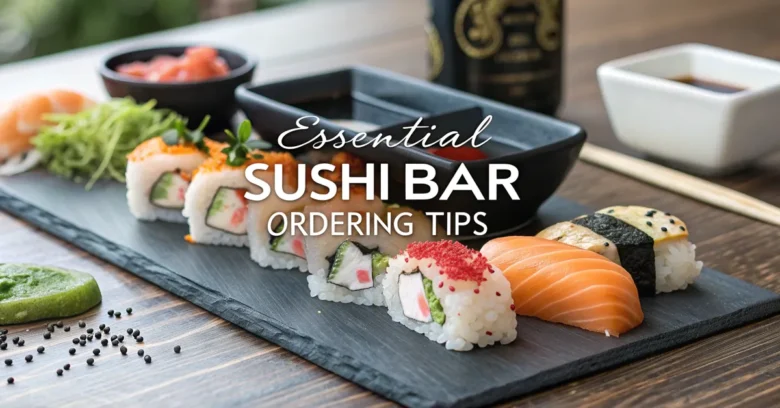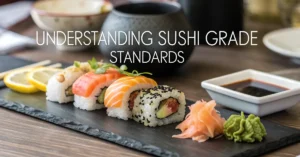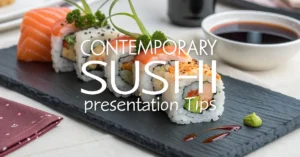Have you ever walked into a sushi bar and felt utterly lost? The sheer variety of fish, the unfamiliar terms, the subtle nuances of etiquette—it can be overwhelming, especially if you’re new to the world of sushi. You’re not alone. Many first-timers feel intimidated, but armed with a little knowledge, you can navigate the menu with confidence and enjoy a truly memorable culinary experience.
This guide will equip you with essential sushi ordering tips, transforming you from a hesitant novice into a savvy sushi aficionado. We’ll cover everything from understanding the menu and deciphering the different types of sushi to mastering basic etiquette and making informed choices. Let’s dive in, so that your next adventure to the sushi bar is seamless and enjoyable!
Understanding the Sushi Menu
The first step toward confident sushi ordering is understanding the layout and language of the menu. While menus can vary from restaurant to restaurant, they generally follow a similar structure. Recognizing common sections and terms will significantly ease the ordering process.
Common Menu Sections
-
Appetizers: This section typically includes small, flavorful dishes designed to whet your appetite. Edamame (steamed soybeans), seaweed salad (wakame), and miso soup are popular choices.
-
Sashimi: Sashimi consists of thinly sliced raw fish, served without rice. The focus is entirely on the quality and flavor of the fish itself.
-
Nigiri: Nigiri is sliced raw fish served over a small, oblong mound of vinegared rice. A dab of wasabi is often placed between the fish and the rice.
-
Maki: Maki refers to sushi rolls, where fish and other ingredients are rolled in rice and seaweed (nori). Common types include:
- Hosomaki: Thin rolls, often with a single ingredient like cucumber (kappa maki) or tuna (tekka maki).
- Chumaki: Medium-sized rolls with a few ingredients.
- Futomaki: Thick rolls with a variety of ingredients.
- Uramaki: Inside-out rolls, where the rice is on the outside and the nori wraps the filling. The California roll is a classic example.
-
Temaki: Temaki are hand-rolled cones of nori filled with rice, fish, and other ingredients. They are meant to be eaten immediately, as the nori can become soggy.
-
Donburi: Donburi dishes consist of a bowl of rice topped with various ingredients, such as seafood, meat, or vegetables.
-
Oshizushi: Oshizushi is pressed sushi, where fish and rice are pressed together in a mold to create a compact, rectangular shape.
-
Sushi Sets/Platters: These are curated selections of sushi, often including a variety of nigiri, maki, and sometimes sashimi. They are a great option for trying a range of flavors and textures.
Deciphering Common Sushi Terms
Navigating a sushi menu involves understanding common Japanese terms. Here are some of the most frequently encountered terms:
-
Nori: Seaweed, used to wrap sushi rolls.
-
Shari: Vinegared rice, the foundation of most sushi.
-
Wasabi: A pungent green paste made from Japanese horseradish. It’s typically served as a condiment and has antibacterial properties.
-
Gari: Pickled ginger, served as a palate cleanser between different types of sushi.
-
Soy Sauce (Shoyu): A salty sauce used for dipping sushi. Be careful not to oversaturate the sushi, as it can overpower the delicate flavors.
-
Maguro: Tuna.
-
Sake: Salmon.
-
Hamachi: Yellowtail.
-
Ebi: Shrimp.
-
Unagi: Freshwater eel, often grilled and glazed with a sweet sauce.
-
Ikura: Salmon roe (eggs).
-
Uni: Sea urchin, known for its rich, creamy flavor.
-
Tako: Octopus.
-
Kani: Crab (often imitation crab).
-
Kappa: Cucumber.
-
Avocado: Avocado.
-
Tobiko: Flying fish roe.
Understanding Fish Grades and Quality
The quality of the fish is paramount in sushi. Understanding fish grades can help you make informed choices.
-
Sushi Grade: This term is often used, but it’s not an officially regulated term. It generally indicates that the fish has been handled and processed in a way that makes it safe for raw consumption. Look for reputable sushi bars that prioritize freshness and proper handling.
-
Farmed vs. Wild-Caught: The origin of the fish can affect its flavor and texture. Farmed fish may have a different fat content and texture compared to wild-caught fish. Some sushi bars specify the origin of their fish on the menu.
-
Seasonal Fish (Shun): Many sushi bars feature seasonal fish, known as “shun.” These fish are at their peak flavor and quality during specific times of the year. Don’t hesitate to ask your server about seasonal offerings.
Exploring Different Types of Sushi
Sushi comes in various forms, each offering a unique combination of flavors and textures. Experimenting with different types of sushi is a great way to expand your palate and discover your preferences.
Sashimi: The Purest Form
Sashimi allows you to appreciate the unadulterated flavor of the fish. High-quality sashimi should have a clean, fresh taste and a smooth, almost buttery texture. Here are some popular sashimi choices:
-
Maguro (Tuna): Tuna sashimi is a classic choice, with different cuts offering varying levels of richness. Akami is a lean cut, while toro (fatty tuna) is prized for its melt-in-your-mouth texture.
-
Sake (Salmon): Salmon sashimi is known for its rich, buttery flavor and vibrant color.
-
Hamachi (Yellowtail): Yellowtail sashimi has a slightly firm texture and a delicate, clean flavor.
-
Tai (Snapper): Snapper sashimi has a mild, slightly sweet flavor and a firm, flaky texture.
-
Hotate (Scallop): Scallop sashimi has a sweet, delicate flavor and a tender, slightly chewy texture.
Nigiri: A Classic Combination
Nigiri combines the simplicity of sashimi with the subtle sweetness of vinegared rice. The rice should be firm but not hard, and the fish should be fresh and flavorful. Here are some popular nigiri choices:
-
Maguro (Tuna): Tuna nigiri is a staple, offering a balanced combination of fish and rice.
-
Sake (Salmon): Salmon nigiri is a popular choice, with the rich flavor of the salmon complementing the vinegared rice.
-
Ebi (Shrimp): Shrimp nigiri features cooked shrimp, offering a slightly sweet and firm texture.
-
Unagi (Eel): Eel nigiri is often grilled and glazed with a sweet sauce, providing a rich, savory flavor.
-
Ikura (Salmon Roe): Salmon roe nigiri features small, orange eggs with a briny, slightly salty flavor.
-
Uni (Sea Urchin): Sea urchin nigiri is a delicacy, known for its rich, creamy, and slightly sweet flavor.
Maki: Endless Variations
Maki offers a wide range of flavors and textures, with endless variations in ingredients and combinations. Here are some popular maki choices:
-
California Roll: A classic uramaki (inside-out roll) filled with crab (often imitation crab), avocado, and cucumber.
-
Spicy Tuna Roll: A maki filled with tuna, spicy mayonnaise, and sometimes cucumber or avocado.
-
Salmon Avocado Roll: A maki filled with salmon and avocado, offering a creamy and flavorful combination.
-
Philadelphia Roll: A maki filled with salmon, cream cheese, and cucumber.
-
Vegetable Roll: A maki filled with a variety of vegetables, such as cucumber, avocado, carrot, and lettuce.
-
Dragon Roll: An elaborate uramaki topped with eel and avocado, often drizzled with a sweet sauce.
-
Rainbow Roll: An uramaki topped with a variety of different types of fish, creating a colorful presentation.
Other Forms of Sushi: Expanding Your Horizons
Beyond sashimi, nigiri, and maki, there are other forms of sushi to explore:
-
Temaki (Hand Rolls): These are a fun, casual way to enjoy sushi. The nori cone is filled with rice, fish, and other ingredients, offering a customizable and interactive experience.
-
Chirashi (Scattered Sushi): Chirashi is a bowl of rice topped with a variety of sashimi, vegetables, and other ingredients. It’s a great way to try a range of flavors and textures in a single dish.
-
Inari Sushi: Inari sushi features vinegared rice stuffed into sweet, seasoned tofu pockets. It’s a simple and satisfying vegetarian option.
Mastering Sushi Etiquette
Sushi etiquette might seem daunting, but it’s based on respect for the food, the chef, and the dining experience. Following a few basic guidelines will enhance your enjoyment and demonstrate your appreciation.
Chopstick Handling
-
Holding Chopsticks: Hold chopsticks correctly, about one-third of the way down from the top. The top chopstick should be movable, while the bottom chopstick remains stationary.
-
Avoid Sticking Chopsticks Upright in Rice: This resembles incense sticks used at funerals and is considered bad luck.
-
Don’t Pass Food with Chopsticks: This is another funeral custom and should be avoided.
-
Don’t Spear Food with Chopsticks: Use chopsticks to gently lift and separate pieces of sushi.
-
Use Chopstick Rests (Hashioki): When not in use, place chopsticks on the provided rest.
Soy Sauce Usage
-
Pour Sparingly: Pour only a small amount of soy sauce into your dipping dish. It’s better to add more as needed than to waste it.
-
Dip Fish-Side Down: When dipping nigiri, try to dip the fish-side down to avoid saturating the rice with soy sauce.
-
Avoid Mixing Wasabi into Soy Sauce: This is generally frowned upon, as it can muddy the flavors. Instead, place a small amount of wasabi directly onto the sushi if desired.
-
Don’t Pour Soy Sauce Over Rice: Soy sauce is meant to complement the fish, not overpower the rice.
Other Etiquette Tips
-
Eat Nigiri in One Bite: This allows you to experience the full flavor combination of fish and rice.
-
Use Pickled Ginger (Gari) as a Palate Cleanser: Eat a slice of ginger between different types of sushi to refresh your palate.
-
Don’t Overuse Wasabi: Wasabi is potent, so use it sparingly.
-
Thank the Chef (Itadakimasu and Gochisosama): Say “Itadakimasu” before eating, which translates to “I humbly receive.” After the meal, say “Gochisosama,” which means “Thank you for the feast.”
-
Be Mindful of Your Phone: Keep your phone silenced and avoid using it during the meal.
Making Informed Sushi Choices
Making informed choices about your sushi order involves considering factors like freshness, sustainability, and personal preferences.
Assessing Freshness
-
Appearance: Fresh fish should have a vibrant color and a glossy sheen. Avoid fish that looks dull, slimy, or discolored.
-
Smell: Fresh fish should have a mild, sea-like aroma. Avoid fish that smells overly fishy or ammonia-like.
-
Texture: Fresh fish should be firm and resilient to the touch. Avoid fish that feels mushy or soft.
-
Reputation: Choose sushi bars with a good reputation for quality and freshness. Read reviews and ask for recommendations.
Sustainable Sushi
-
Choose Sustainable Options: Some fish species are overfished or caught using methods that harm the environment. Opt for sustainable sushi choices whenever possible.
-
Consult Seafood Guides: Use seafood guides like the Monterey Bay Aquarium’s Seafood Watch (https://www.seafoodwatch.org/) to identify sustainable sushi options.
-
Ask Your Server: Don’t hesitate to ask your server about the origin and sustainability of the fish.
Considering Dietary Restrictions and Preferences
-
Communicate Your Needs: Inform your server about any dietary restrictions, allergies, or preferences you may have.
-
Vegetarian Options: Many sushi bars offer vegetarian options, such as cucumber rolls (kappa maki), avocado rolls, and vegetable rolls.
-
Gluten-Free Options: Most sushi rice is gluten-free, but soy sauce contains gluten. Ask for tamari, a gluten-free soy sauce alternative.
-
Allergies: Be particularly cautious if you have allergies to fish, shellfish, or sesame. Ensure that your sushi is prepared separately to avoid cross-contamination.
Tips for a Smooth Sushi Ordering Experience
Here are a few additional tips to ensure a smooth and enjoyable sushi ordering experience:
-
Start Small: If you’re new to sushi, start with a small order to sample different flavors and textures.
-
Don’t Be Afraid to Ask Questions: Sushi chefs and servers are generally happy to answer your questions and provide recommendations.
-
Consider an Omamakase: If you’re feeling adventurous, consider ordering “omakase,” which means “I’ll leave it to you.” This allows the chef to create a personalized selection of sushi based on the freshest and best ingredients available.
-
Pace Yourself: Sushi is meant to be savored and enjoyed. Take your time and appreciate the subtle flavors and textures.
-
Respect the Chef: Show your appreciation for the chef’s skill and artistry by enjoying the sushi as intended.
-
Enjoy the Experience: Sushi is more than just food; it’s an art form and a cultural experience. Relax, be open to new flavors, and enjoy the journey.
Expanding Your Sushi Horizons
Once you’ve mastered the basics of sushi ordering, there are many ways to further expand your knowledge and appreciation.
Learning About Regional Variations
Sushi styles and ingredients vary across different regions of Japan. Exploring regional variations can provide a deeper understanding of the art of sushi.
-
Edomae Sushi (Tokyo): Edomae sushi is the classic style of sushi that originated in Tokyo. It emphasizes fresh, local seafood and simple preparations.
-
Osaka-Style Sushi: Osaka-style sushi is known for its pressed sushi (oshizushi) and mackerel sushi (battera).
-
Kyoto-Style Sushi: Kyoto-style sushi often features pickled or preserved fish and vegetables, reflecting the region’s culinary traditions.
Trying Different Types of Fish
Experimenting with different types of fish is a great way to expand your palate and discover new favorites.
-
Kohada (Gizzard Shad): Kohada is a small, silver-skinned fish with a distinctive flavor that is often marinated in vinegar.
-
Aji (Horse Mackerel): Aji has a firm texture and a slightly oily flavor.
-
Saba (Mackerel): Saba has a strong, distinctive flavor and a slightly oily texture. It’s often marinated in vinegar or salt.
-
Sanma (Pacific Saury): Sanma is a seasonal fish that is typically grilled or served as sashimi.
Exploring Japanese Cuisine Beyond Sushi
Sushi is just one facet of the rich and diverse world of Japanese cuisine. Exploring other dishes can complement your sushi experience and broaden your culinary horizons.
-
Ramen: A noodle soup with a rich broth, various toppings, and flavorful noodles.
-
Tempura: Lightly battered and deep-fried seafood and vegetables.
-
Yakitori: Grilled skewers of chicken, vegetables, or other ingredients.
-
Udon: Thick wheat noodles served in a variety of broths with different toppings.
-
Soba: Thin buckwheat noodles served hot or cold.
-
Okonomiyaki: A savory pancake made with flour, eggs, and shredded cabbage, with various toppings.
Visiting Japan: The Ultimate Sushi Experience
For the ultimate sushi experience, consider visiting Japan. You’ll have the opportunity to sample the freshest, highest-quality sushi in the world, prepared by master chefs using traditional techniques.
-
Tsukiji Outer Market (Tokyo): A bustling market with a wide variety of seafood, produce, and other culinary delights.
-
Local Sushi Bars: Seek out small, family-run sushi bars in different regions of Japan for an authentic and unique experience.
-
Sushi-Making Classes: Take a sushi-making class to learn the art of sushi from a master chef.
Time to Order Sushi Like a Pro!
Armed with these tips and insights, you’re now ready to confidently walk into a sushi bar and order like a seasoned pro. Remember to start small, don’t be afraid to ask questions, and be open to trying new things. Most importantly, remember that sushi is meant to be enjoyed – savor each bite, appreciate the artistry, and embrace the experience. So go ahead, take your newfound knowledge for a spin, and discover a world of flavors awaiting your palate!



